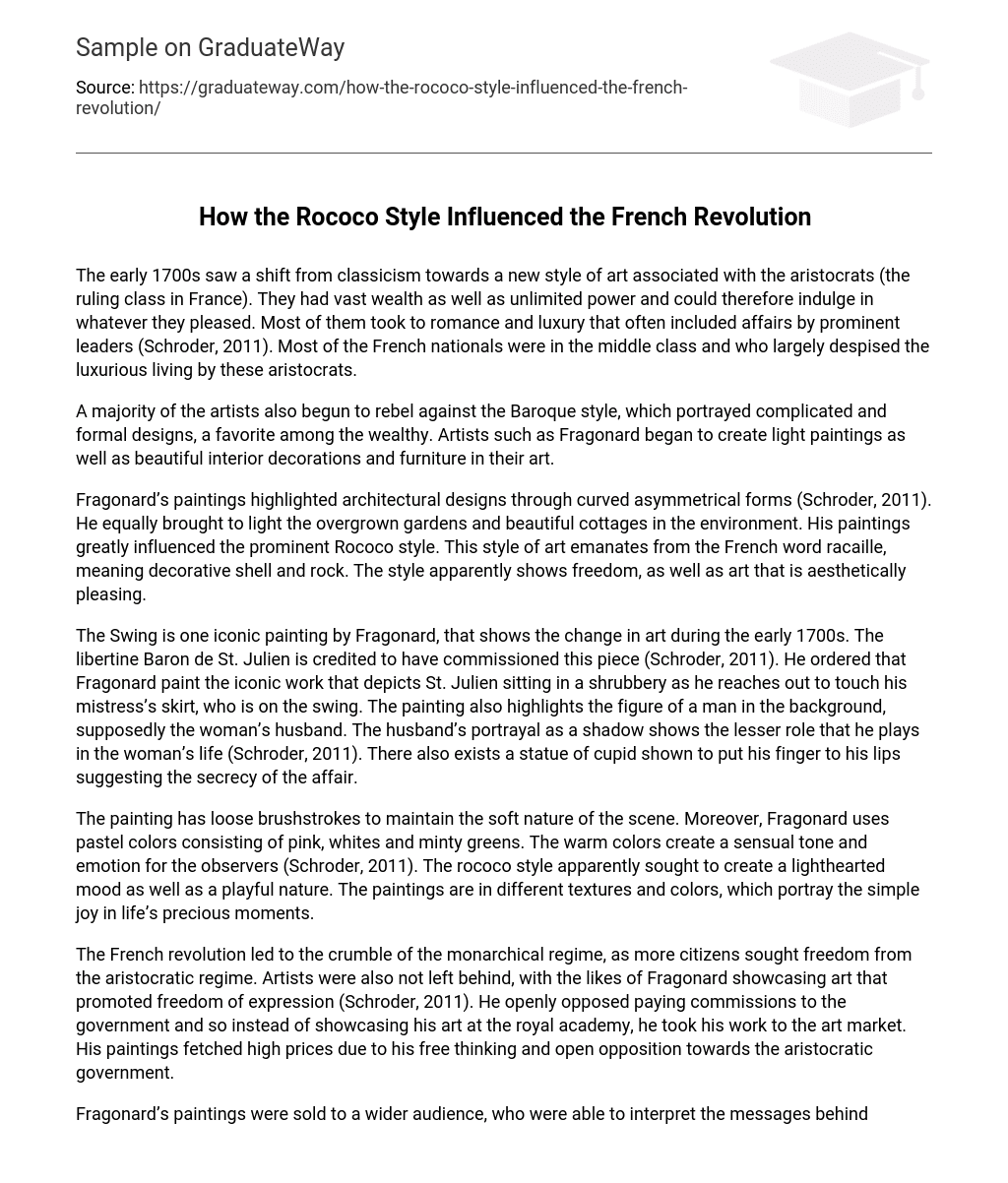The early 1700s saw a shift from classicism towards a new style of art associated with the aristocrats (the ruling class in France). They had vast wealth as well as unlimited power and could therefore indulge in whatever they pleased. Most of them took to romance and luxury that often included affairs by prominent leaders (Schroder, 2011). Most of the French nationals were in the middle class and who largely despised the luxurious living by these aristocrats.
A majority of the artists also begun to rebel against the Baroque style, which portrayed complicated and formal designs, a favorite among the wealthy. Artists such as Fragonard began to create light paintings as well as beautiful interior decorations and furniture in their art.
Fragonard’s paintings highlighted architectural designs through curved asymmetrical forms (Schroder, 2011). He equally brought to light the overgrown gardens and beautiful cottages in the environment. His paintings greatly influenced the prominent Rococo style. This style of art emanates from the French word racaille, meaning decorative shell and rock. The style apparently shows freedom, as well as art that is aesthetically pleasing.
The Swing is one iconic painting by Fragonard, that shows the change in art during the early 1700s. The libertine Baron de St. Julien is credited to have commissioned this piece (Schroder, 2011). He ordered that Fragonard paint the iconic work that depicts St. Julien sitting in a shrubbery as he reaches out to touch his mistress’s skirt, who is on the swing. The painting also highlights the figure of a man in the background, supposedly the woman’s husband. The husband’s portrayal as a shadow shows the lesser role that he plays in the woman’s life (Schroder, 2011). There also exists a statue of cupid shown to put his finger to his lips suggesting the secrecy of the affair.
The painting has loose brushstrokes to maintain the soft nature of the scene. Moreover, Fragonard uses pastel colors consisting of pink, whites and minty greens. The warm colors create a sensual tone and emotion for the observers (Schroder, 2011). The rococo style apparently sought to create a lighthearted mood as well as a playful nature. The paintings are in different textures and colors, which portray the simple joy in life’s precious moments.
The French revolution led to the crumble of the monarchical regime, as more citizens sought freedom from the aristocratic regime. Artists were also not left behind, with the likes of Fragonard showcasing art that promoted freedom of expression (Schroder, 2011). He openly opposed paying commissions to the government and so instead of showcasing his art at the royal academy, he took his work to the art market. His paintings fetched high prices due to his free thinking and open opposition towards the aristocratic government.
Fragonard’s paintings were sold to a wider audience, who were able to interpret the messages behind the art. His portrayal of women as the focus of attention helped improve the image of women during and after the revolution (Schroder, 2011). Consequently, the embodiment of the female empowerment led to a major cultural shift. It is evident that his pieces of art enlightened the masses that resulted in more protests against the wealthy aristocrats.
Fragonard’s family also took part in protests against the government. His wife and sisters donated their jewels to the revolutionary government to support the revolution. Such an act demonstrated his patriotism to his country and its democratic values (Schroder, 2011).
Fragonard was later elected to the new government, acquiring influential positions in art department. He could, therefore, interact with Napoleons representatives, who helped propel his work and message (Schroder, 2011). In this light of view, Fragonard serves as an example of an independent and influential artist in the French revolution. His art helped change the political times through his strong yet light-hearting pieces.
Reference
- Schroder, A. L. (2011). Fragonard’s Later Career: The Contest et Nouvelles and the Progress of Love Revisited. Art Bulletin, 93(2), 150–177. Retrieved from http://search.ebscohost.com/login.aspx?direct=true&db=aph&AN=65093928&site=ehost-live





